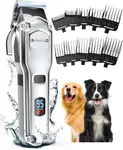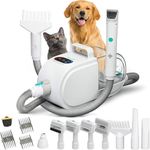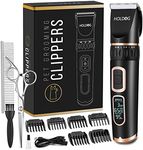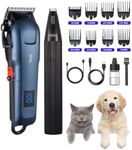Buying Guide for the Best Clippers For Dogs With Thick Coats
Choosing the right clippers for dogs with thick coats is important to ensure both the comfort of your pet and the ease of grooming. Thick coats can be challenging to trim, so you need clippers that are powerful, reliable, and designed to handle dense fur without pulling or overheating. Understanding the key features will help you select a clipper that matches your dog's needs and your grooming habits.Motor PowerMotor power refers to how strong and fast the clipper's engine is. This is crucial for thick coats because a weak motor can get stuck or slow down, making grooming difficult and uncomfortable for your dog. Motors are often described as single-speed, multi-speed, or rotary. Single-speed motors are simpler and quieter, but may struggle with very thick fur. Multi-speed or rotary motors offer more power and flexibility, making them better for dense coats. If your dog has a very thick or matted coat, look for clippers with a strong, high-speed motor to ensure smooth and efficient cutting.
Blade Type and QualityThe blade is the part that actually cuts the hair, so its type and quality matter a lot. Blades can be made from stainless steel, ceramic, or other materials. Ceramic blades stay cooler longer, which is helpful for long grooming sessions, while stainless steel blades are durable and easy to maintain. Some blades are detachable, making them easier to clean and swap out for different lengths. For thick coats, sharp, high-quality blades are essential to avoid pulling or snagging. Choose a clipper with strong, sharp, and preferably detachable blades for the best results.
Clipper Weight and ErgonomicsThe weight and shape of the clipper affect how comfortable it is to use, especially during long grooming sessions. Heavier clippers can be tiring to hold, while lighter ones are easier to maneuver but may not always be as powerful. Ergonomic designs with comfortable grips help reduce hand fatigue. If you plan to groom your dog regularly or have a large dog, look for a clipper that feels balanced and comfortable in your hand.
Corded vs. CordlessClippers come in both corded and cordless versions. Corded clippers provide consistent power and are great for long sessions, but the cord can get in the way. Cordless clippers offer more freedom of movement and are easier to use around a squirmy dog, but they rely on battery life, which can be limiting for thick coats that take longer to trim. If you need flexibility and your grooming sessions are short, cordless may be best. For longer or more demanding grooming, a corded model might be more reliable.
Noise and Vibration LevelSome dogs are sensitive to loud noises or strong vibrations, which can make grooming stressful. Clippers vary in how much noise and vibration they produce. Quieter, low-vibration models are better for nervous dogs, but sometimes these are less powerful. If your dog is anxious, look for clippers advertised as quiet or low-vibration, but make sure they still have enough power for thick coats.
Maintenance and CleaningRegular maintenance keeps your clippers working well and extends their life. Some clippers are easier to clean and oil than others, and detachable blades make this process simpler. If you want a low-maintenance option, look for clippers with easy-to-remove blades and clear cleaning instructions. This is especially important for thick coats, as hair can build up quickly.
















